|
Anti-Aircraft Command.
©.pinterest.com
Anti-aircraft defences came under the command of the Royal Artillery, although their disposition was nominally under RAF control. This arrangement required great tact and understanding between Dowding and C in C A.A Command, Lt. Gen. Sir Frederick Pile, who were fortunately on the best of terms and and fully supportive of each other's efforts. The Command was divided nationally into seven Divisions which were linked to Fighter Command Group areas.
The figures shown above are strengths for July 1940 and the changes made by October, (in brackets). The deployement of guns was not equally divided between the Divisions them as there was an acute shortage of anti-aircraft guns. The majority were deployed in urban areas, particularly London, with heavy concentrations protecting industrial targets. After Dunkirk is was estimated that 3,744 heavy (4 in to 4.7in) A.A guns were needed for the defence of Britain but only 1,073 were available. This was increased to 1,247 by early October. As for RDF gun-laying equipment, only eleven sets were available by the beginning of September but were plagued with problems in bad weather. The primary role of the Command was twofold: to protect the aircraft manufacturing industry and to support Fighter Command. A third benefit that came to be realised was that being on the ground and seen to be working hard, the batteries were a great morale booster to the civilian population. A bonus that should not be underrated. Wherever possible the batteries used aimed, rather than battery fire as the mathematical complexities of the task, amplified by the shortage of resources, were vast. Anti-aircraft fire was more effective in daylight than at night as the incoming bomber streams were in closer formations But at night the aircraft were very widely spaced and it was calculated that to have a 1:50 chance of hitting a single aircraft flying at 250mph through a box ten miles long and four miles high, over 3,000, 3.7in rounds per second would need to be fired. In 1940 Anti-Aircraft Command was the most effective means of defence against attacks at night Despite their many difficulties this, largely unrecognised Command was three times more effective at night than Fighter Command in shooting down enemy aircraft. Between June and December 1940, anti-aircraft gunners claimed 102 aircraft against Fighter Command's claim of 35.
|
